
Renovating eroded soil
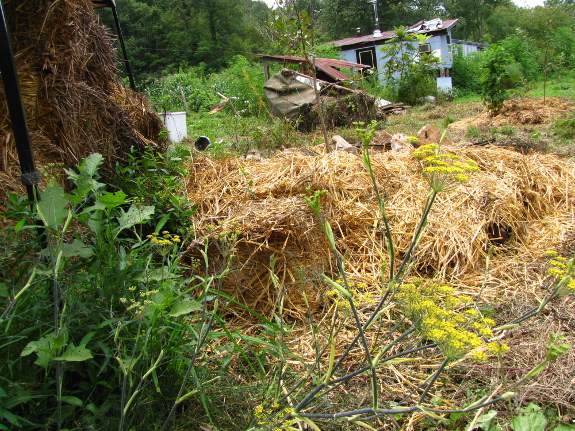
The forest garden area we
renovated on Thursday
has been a major experimenting ground for me because I'm trying to find
a way to grow useful plants on highly degraded soil. Previous
owners had used this spot as a pasture, and I suspect they overgrazed
it so much that every bit of topsoil eroded away. As a result,
there's a gully leading from the forest garden down to the floodplain,
absolutely no topsoil above the bare clay remaining in 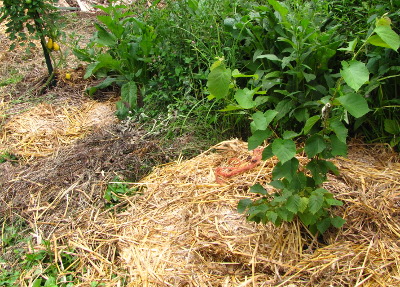 place, and a
very high water table. On the positive side, the spot gets good
sun and is close to our trailer, so it's easy to keep the deer
out. Clearly, the ground is worth renovating back into production.
place, and a
very high water table. On the positive side, the spot gets good
sun and is close to our trailer, so it's easy to keep the deer
out. Clearly, the ground is worth renovating back into production.
I'm slowly figuring out
ways to grow things in this extremely sub-prime
soil. The trick is to raise the plants' roots up high enough that
they don't drown while also adding enough organic matter and mulch that
the plants have something to eat and don't dry to a crisp in the summer
sun. Planting
trees in raised beds
works well for year one, but by year two the trees want to spread their
roots further, so I need to keep expanding the mound --- this winter's hugelkultur
donuts seem to have
been a good option in that regard.
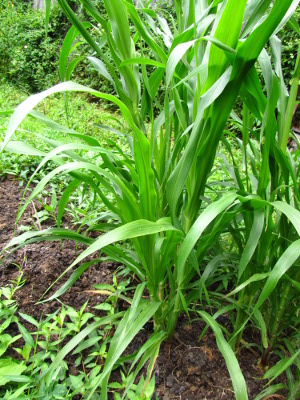
Since there's a lot of
empty space between the young fruit trees, I've also been
experimenting with making instant raised beds out of a layer of
cardboard topped by a bunch of composted manure. I can plant
annual crops on these rich raised beds and get a return on my
investment in year one. Meanwhile, by attaching the vegetable
beds to my tree islands, I'm also giving my fruit trees room to
grow. This idea works great if you mulch the manure beds
immediately so the top doesn't crust up, then transplant in tomatoes or
direct-seed squash into small, mulch-free areas. Without mulch,
though, the cowpeas, field corn, and amaranth I planted in another bed
barely germinated (although pearl millet seems to be hardy enough that
even scattered on the manure surface, enough seeds sprouted to make
the stand pictured here.)
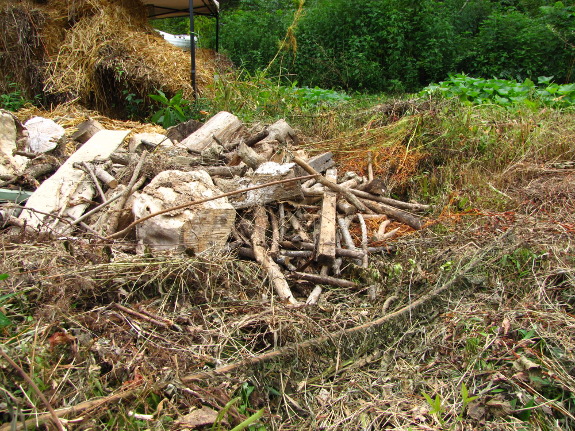
When Mark cut all of the
weeds I'd let grow up over our heads, I raked
some into piles alongside the tree beds for a new experiment. My
hope is that they'll rot down slowly enough that the greenery will act
like a kill mulch and smother weeds underneath. Meanwhile, the
composting weeds will add organic matter and height to the soil.
I even threw some firewood that was too punky to
split into the lowest spot for yet more height and organic matter.
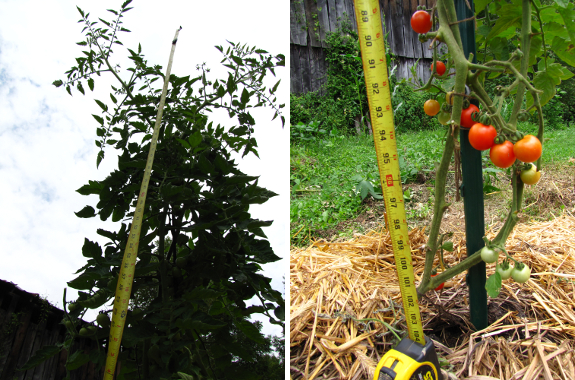
The beauty of
permaculture is that every problem can be viewed as a
benefit. Yes, this part of the garden is extremely troubled, but
the high groundwater acts to subirrigate
my beds, keeping roots moist and the leaves dry. The tomatoes in
the forest garden are taller than the unwatered tomatoes in tomato
alley and less blighted than the tomatoes in the watered part of
the mule garden. Maybe I should plant all of my tomatoes here
next year?
Want more in-depth information? Browse through our books.
Or explore more posts by date or by subject.
About us: Anna Hess and Mark Hamilton spent over a decade living self-sufficiently in the mountains of Virginia before moving north to start over from scratch in the foothills of Ohio. They've experimented with permaculture, no-till gardening, trailersteading, home-based microbusinesses and much more, writing about their adventures in both blogs and books.
Want to be notified when new comments are posted on this page? Click on the RSS button after you add a comment to subscribe to the comment feed, or simply check the box beside "email replies to me" while writing your comment.

What about terraced gardens with either punky wood or a more permanent retaining feature like rock if you have any? It would be easier to build up small areas of good soil in retained bads than one large one. Leave the clay for your path ways.
Love all of your pictures and your intelligent and common sense approaches
Alison
Despite the erosion, terraces aren't necessary. The ground is actually only barely sloped, which is why I think it had to have been grazed bare to cause any erosion to happen.
In our vegetable garden, we used a technique a bit like what you're suggesting, shoveling the topsoil onto raised beds and leaving the subsoil for the aisles. Unfortunately, in the forest garden, there is no topsoil. Plus, when I tried to shovel some of the clay up to make raised beds, I caused more problems since the groundwater is so high that even a tiny trench fills with water. The water doesn't stick around well enough to make ponds or support marsh plants, unfortunately, but does stay long enough to kill dry land plants. So I end up with bare spots --- just what I'm trying to avoid! Which is all a long way of explaining why I'm adding external inputs to make big raised beds and leaving the paths at ground level.